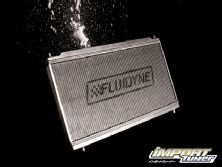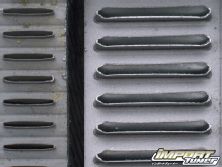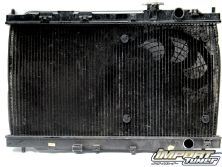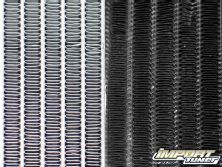We faced these heat problems with our eBay-sponsored Editors' Charity Challenge Integra. Our turbocharged street beast laid down 371 hp at 18 psi of boost, before we blew a head gasket. When it blew, a lot of air was suddenly looking for a place to go, and without the head gasket doing its job, that air went to the water jacket surrounding each cylinder. This put an unexpectedly high amount of pressure in the cooling system and damaged our radiator. The stock radiator was only designed to cool a 150-hp normally aspirated engine, so it couldn't meet our cooling demands. That meant upgrades.
Two basic premises for increasing cooling capabilities are fluid capacity and core surface area. The stock core was 18mm thick and had a capacity of 2 liters. By increasing the core thickness, you will also increase the volume and area, which will allow you to cool a larger mass.
We chose a Fluidyne performance radiator as a replacement. It's a direct-fit design, with an all-aluminum construction. It has a 38mm core with high-efficiency fins, polished- and heliarc-welded aluminum end tanks and a 16 psi cap. Because the core is 20mm thicker than stock, its capacity is bumped up to 3.1 liters. Fluidyne's thicker core might imply restricted airflow through the radiator; however Fluidyne's high-flowing fin design is more efficient than stock, allowing excellent heat dissipation despite the added core thickness. Also, the Fluidyne cores are brazed rather than epoxied to ensure long-lasting and reliable performance. The heliarc-welded aluminum end tanks are also superior to stock, since these will not crack or develop leaks the way stock, plastic end tanks do. Fluidyne claims the added surface area and volume equate to approximately a 20-percent improvement over the stock radiator in cooling performance.
An added advantage is the all-aluminum construction. Older radiators constructed from brass or copper were heavy and susceptible to corrosion. Aluminum is a lightweight, highly effective alternative.
Another factor to consider is the radiator cap. Radiator caps control the pressure buildup in the coolant. If the coolant becomes too hot, it will boil and create vapor. Vapor cannot absorb heat. To keep the water in its liquid state longer, higher pressure caps can be used to raise the fluid's boiling point. Typically, stock caps have lower pressure thresholds because the stock engines don't require that much cooling capacity. Fluidyne radiators have a 16 psi cap, but higher pressure caps are also available for greater performance.
Choosing a radiator and a cap is only the beginning when it comes to upgrading your cooling system. Coolant mixture, thermostat, hoses and fans are also items to consider. When you start messing with power adders or creating high ambient temperatures on the track, you must improve the cooling system. For a cool $439.95 we took the first preventative steps toward controlling soaring engine temperatures. Given what's at stake--our engine--the Fluidyne radiator is worth every penny.




